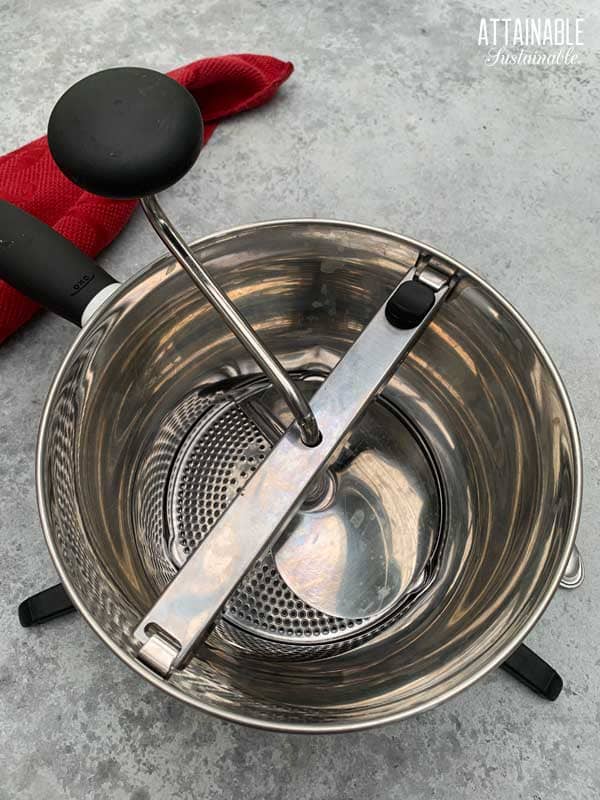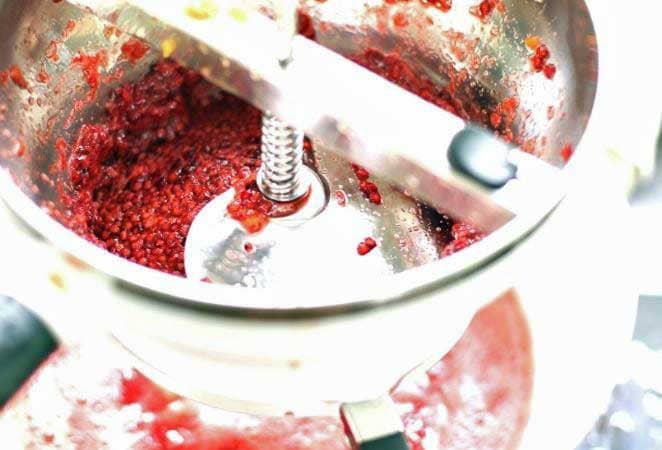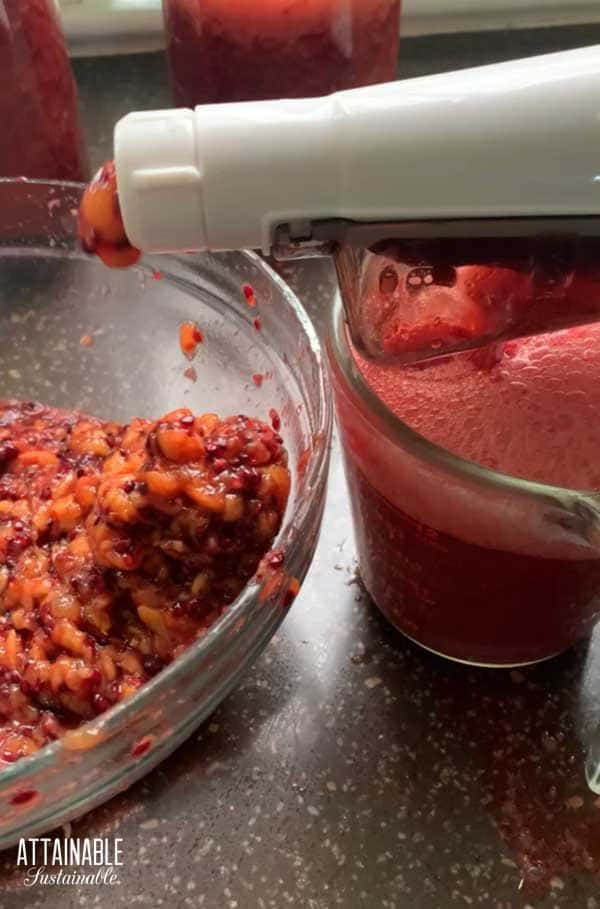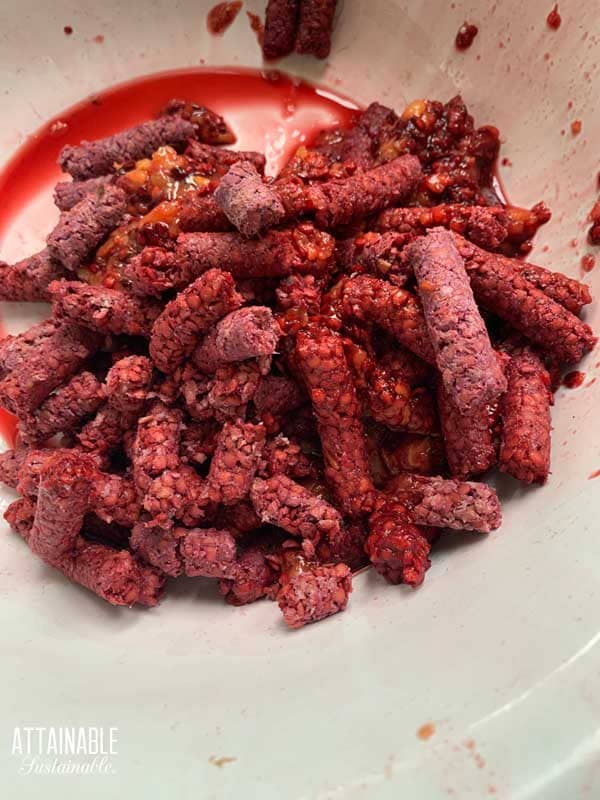Once you learn how to use a food mill, you won’t look back. If you do a lot of cooking, canning, or baking from scratch, using a food mill will make your life so much easier. It’s simply the best kitchen gadget for removing skins, seeds, stems, and other solids from recipes like sauces, soups, and jams.
Another tool that is useful in the kitchen is a citrus zester. Learn how to use one here.
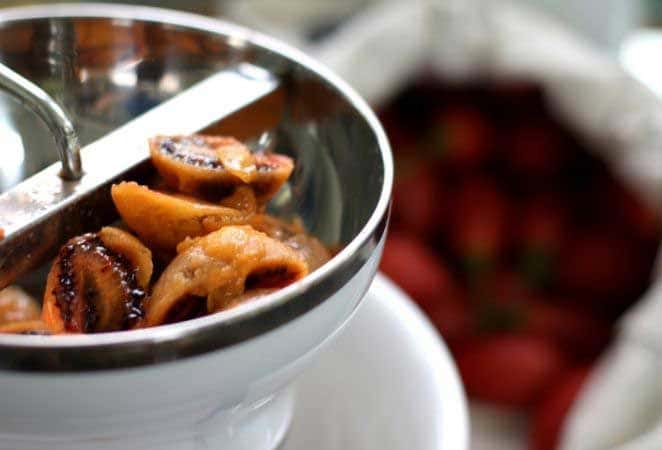
What is a Food Mill Used For?
Food mills have a variety of uses in the kitchen. Pretty much any recipe that needs a smooth, sauce-like consistency is perfect for a food mill. You’ll need to start with soft or semi-solid ingredients, so most fruits and veggies need to be steamed, boiled, or baked before processing.
- A food mill essentially mashes and strains foods. It’s ideal for straining the soft portion of foods from the solids (say, seeds and peelings), creating a smooth consistency for sauces and similar recipes.
- It saves the time and energy you’d spend peeling and deseeding ingredients.
- It also leaves less food waste, because it efficiently removes the solids without wasting the rest. The solids can be thrown away or composted.
Recipes you can make with your food mill include:
- Jams, jellies, and preserves
- Bean dips and hummus
- Applesauce (if you like it really fine-textured)
- Tomato sauce or ketchup
- Fluffy mashed potatoes
- Creamy soups (like potato or pumpkin)
- Baby food
- Pureed fruits for baking with fillings, toppings, and swirls
- A pulpy juice, such as this blueberry juice.
Manual Food Mills vs. Electric Food Mills
Both manual and electric food mills work by adding cooked, whole fruits or veggies to the inner bowl, which are then pushed through the strainer. This mashes the food and removes solid materials like skins and seeds.
Manual food mills are budget-friendly and are still plenty useful in the kitchen, but an electric version is a necessity for big batch food preparation. Here’s a quick rundown of the differences between the two:
Manual Food Mills:
- Very inexpensive (about $25 to $50 for a basic model)
- Consists of a bowl, a straining disc, and a hand crank
- Saves space if you’re short on storage
- Hand crank to push the food through the mill
- Perfect for small batch cooking
Electric Food Mills:
- More expensive (expect to pay $80 to $120 or more)
- Takes up more space in your kitchen
- Also consists of a bowl and straining disc, but it’s powered electrically
- No hand-cranking or manual labor needed
- Makes large batch food prep much easier
If you like the idea of an electric appliance but not the price, look into attachments for equipment you may already have. Some stand mixers and grinders have reasonably priced accessories for juicing.
I’ve just tracked down an attachment for my LEM countertop grinder. It does an amazing job of removing much of the pulp, often leaving behind dry chunks of seed and skin.
Using Different Discs
Most food mills come with a few discs with different hole sizes that yield different results. Here’s how to choose which discs to use based on what you’re preparing:
- The smaller the holes, the finer and smoother the end results.
- Also consider the size of the seeds in the fruits or veggies you’re milling. Smaller seeds will need smaller holes to sieve them out.
- Coarse discs are good for mashing potatoes and other veggies.
- Medium discs with are perfect for smooth tomato sauces, creamy soups, baby food, and fruit purees.
- Fine discs are ideal for fruit syrups that need to be finely strained or for when you want an extra smooth result for sauces and purees.
In some cases, you may want to process the pulp twice to get the most out of the fruit.
What is the difference between a food mill and a food processor?
It’s tempting to think you can use a food processor instead of a food mill, but they’re actually two very different gadgets.
- A food processor doesn’t strain away solids. Instead, it simply grinds them up. It creates a pulpy texture rather than a smooth one.
- For example, if you puree blackberries in a food processor, you’ll be left with gritty skins and seeds. A food mill will strain these away.
- Food processors can roughly chop solid foods like nuts or oats to make a coarsely ground meal.
- They’re also more effective for a chopped or diced consistency, such as salsas.

